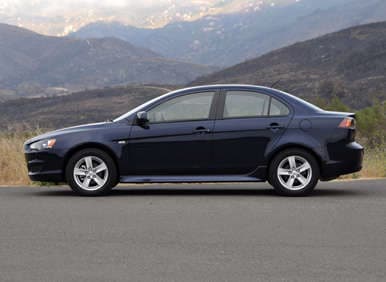Recent Articles
Popular Makes
Body Types
2013 Mitsubishi Lancer Sedan Road Test and Review
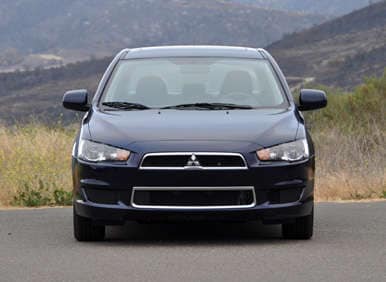
Late last year, the automotive market intelligence division of a powerful credit reporting agency*, said that consumers who finance the purchase of a Mitsubishi have, as a group, the lowest average credit scores of any brand sold in the United States.
Ouch. That hurts. But it makes sense.
The once promising Japanese automaker that built compelling alternatives to the Hondas and Nissans and Toyotas that everyone else bought, the car company that capitalized on the passion of car enthusiasts in love with turbocharged, all-wheel-drive fun-mobiles, lost its way after deciding to go big or go home. The resulting “Project America” plan bloated the Eclipse sport coupe, made the Galant sedan a me-too midsizer, and produced the truly strange Endeavor crossover SUV. Americans were none too impressed.
This product strategy misfire, followed by too much investment in and focus on the i-MiEV electric golf cart…I mean, car…has left Mitsubishi heavily reliant on the glow produced by the Lancer Evolution, a truly awesome machine even in its currently advanced stage of age.
The car depicted on this page is not the legendary Evo. It is the Lancer Sedan in SE trim. This is the car Mitsubishi dealers try to sell to people who want an Evo but who can’t swing the payment, either for the car, or for the insurance, or because their credit rating won’t let them qualify for a loan on a $35,000 road rocket.
Having now spent a week with Mitsubishi’s only mainstream car, I can tell you that the SE, which is equipped with standard All-Wheel Control (AWC), is a smart idea. Unfortunately, the packaging is merely mediocre.
* Experian Automotive
2013 Mitsubishi Lancer Sedan Road Test and Review: Models and Prices
The 2013 Mitsubishi Lancer lineup includes the sedan (starting at $16,790 including the $795 destination charge), the Sportback ($19,290), and the Evolution ($35,490).
A turbocharged, 291-horsepower, all-wheel-drive rally car for the road, the Lancer Evolution is a phenomenon unto itself. The Lancer Sportback is a racy-looking 5-door hatchback that adds something unique to the mainstream Lancer lineup. Unfortunately, turbocharging is not a part of this car’s recipe. That leaves the Lancer Sedan to provide the greatest diversity to Mitsubishi buyers.
Not counting the Evo, five versions of the Lancer Sedan are for sale: the DE, the ES, the SE, the GT, and the Ralliart. My test car was the SE, a model that Mitsubishi says was “designed for the Snowbelt states.” As such, it comes standard with the automaker’s AWC all-wheel-drive system, packaged with heated cloth front seats and heated side mirrors. The engine is larger and more powerful than what’s installed in the Lancer ES, and the SE is equipped with standard 16-inch aluminum wheels and chrome lower grille trim for an improved appearance.
A new Premium Package is offered for 2013, and my car had it, bringing the total price to $22,640. The Premium Package adds a leather-wrapped steering wheel and shift knob, soft touch upper door panel material, upgraded gauges, a power sunroof, and a 710-watt premium audio system with satellite radio and, yes, a CD changer.
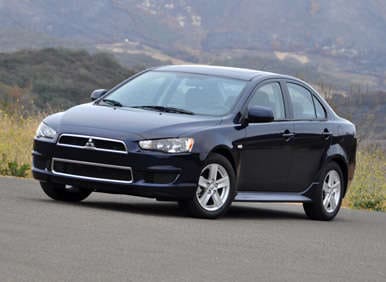
2013 Mitsubishi Lancer Sedan Road Test and Review: Design
- New 16-inch aluminum wheel design standard for SE
- New Premium Package for SE adds soft-touch upper door panel material, leather-wrapped steering wheel and shift knob
You know, a Lancer without the Evo treatment isn’t a bad looking car. It is conservative in comparison to its flamboyantly spoilered and scooped performance-tuned sibling, but the Lancer’s looks are fundamentally appealing except for the car’s excessive front overhang. Buyers seeking more visual flair can dress the Lancer SE up with a front air dam, a rear wing spoiler, an exhaust finisher, extra chrome, and an alloy fuel door.
That’s nice, but it would be better if the company figured out how to make the doors and trunk lid sound solid and secure instead of clunky and junky when slamming them shut.
If the Lancer’s exterior is conservative, the interior is downright plain. The good thing is that most of the controls are easy to find, use, and reference. The bad thing is that the plastics used inside the Lancer are cheap in terms of look and feel, and controls such as the driver’s seat height adjuster and the sun visors seemingly threaten to break when used. An optional LED Illumination Package adds ambient cabin lighting, and the Lancer SE can be upgraded with aluminum interior accents and leather seats.

2013 Mitsubishi Lancer Sedan Road Test and Review: Comfort and Cargo
- Available plug-in roof carrier attachments for SE
While installing child safety seats in the back of the Lancer, I leaned in with my right knee on the seat cushion to fasten LATCH straps and tighten things down. By putting a substantial portion of my 250 pounds on a concentrated portion of the back seat cushion, my knee nearly sank through to the floor. That has never, ever happened to me before.
The lack of foam density in the seats makes them feel soft, cushy, and inviting at first, but there isn’t much in the way of support here. And while Mitsubishi might think the Lancer is a “mid-size sports sedan,” I disagree on both counts. Rear seat leg and foot space aren’t necessarily any better than the compact sedans against which the Lancer logically competes.
The front seats are also plush and lacking in support. People accustomed to spending lots of time in recliners watching TV will feel right at home, and the bolstering is about as effective as a La-Z-Boy at holding occupants in place in the event the driver takes a corner in spirited fashion. Despite a manual seat height adjuster, I still felt like I sat too low behind the Lancer’s steering wheel.
My test car had the optional Premium Package, which includes a premium sound system with a giant subwoofer installed on the left side of the trunk. It drops cargo volume from 12.3 cu.-ft. to 11.8 cu.-ft. Young buyers might find that acceptable, but I think that what they really want is Bluetooth connectivity with music streaming, Internet radio, a USB port, and SMS text messaging.
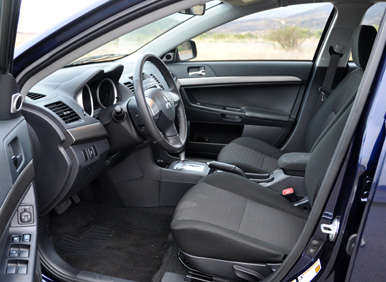
2013 Mitsubishi Lancer Sedan Road Test and Review: Features and Controls
- Optional Premium Package for SE includes premium audio system, power sunroof, upgraded instrumentation
inexpensive cars tend to be simplistic in terms of control layout and feature count, and the 2013 Lancer is no exception. The “Info” button used to cycle through the trip computer’s screens is hidden behind the steering wheel rim, and the heated seat buttons are tucked up tight to the center armrest, but once an owner knows they’re there, it’s not a problem. What I did not get used to was the tiny little fuel level graphic on the busy display screen nestled between the car’s gauges.
Otherwise, my main complaint has to do with the radio controls. I’m glad to have a volume knob and a tuning knob to use, but they are small and shallow, and my big stubby fingers have a problem gripping them. When used in conjunction with satellite radio, the tuning knob cycles through programming types, and then the Seek/Track buttons are used to move between stations. This arrangement ought to be reversed.
The Rockford Fosgate audio system is loud. And boomy. It offers a variety of settings to help any young driver find an appropriate level of attention-getting volume and a commensurate level of hearing damage. But, in my test car, I couldn’t connect my smartphone and stream some nice, mellow Jack Johnson or my Xx station on Pandora. Instead, I would need to dig my CDs out of a box in my garage.
Alternatively, I could spend another $395 to get Bluetooth hands-free calling and a USB port. Another option not included in my test car was a touchscreen navigation system with a music server and real-time traffic reports.

2013 Mitsubishi Lancer Sedan Road Test and Review: Safety and Ratings
- No changes for 2013
Aside from a standard knee airbag for the driver, the Lancer GT and Ralliart models can be equipped with a reversing camera and rain-sensing wipers. Rear parking assist sensors are a dealer-installed add-on for any Lancer.
The National Highway Traffic Safety Administration (NHTSA) gives the Lancer a 4-star overall crash-test rating, but you should take note of the car’s 3-star, rear-seat, side-impact test result. The Insurance Institute for Highway Safety (IIHS) says the 2013 Lancer is a “Top Safety Pick.”
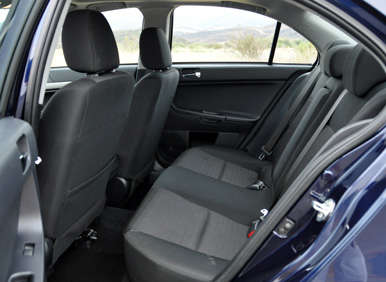
2013 Mitsubishi Lancer Sedan Road Test and Review: Engines and Fuel Economy
- No changes for 2013
The Lancer DE and ES models are equipped with a 148-horsepower, 2.0-liter 4-cylinder engine and a 5-speed manual transmission. A continuously variable transmission (CVT) is optional only for the Lancer ES.
Stepping up to the Lancer SE or GT installs a 168-horsepower, 2.4-liter 4-cylinder engine under the hood. The SE comes standard with a CVT. The GT has a 5-speed manual or a Sportronic version of the CVT with six “gears” that can be manually selected using paddle shifters on the steering wheel. Considering that this engine generates barely enough juice to make the car feel like it is, in fact, accelerating, I strongly recommend it.
Lancer Ralliart models get a powerful 237-horsepower 2.0-liter 4-cylinder with a turbocharger and a thick wad of torque between 2,500 rpm and 4,750 rpm. An automated manual transmission puts the power to the pavement through a full-time version of AWC with an Active Center Differential, and front and rear limited-slip differentials.
I’ve driven a Lancer Ralliart. It was fun. My Lancer SE, not so much.
A Ralliart quaffs premium at the rate of 20 mpg in combined driving. My Lancer SE is EPA-rated to return 25 miles of travel for every gallon of regular unleaded. I averaged 24.4 mpg on my test loop, which included city, mountain, coastal, rural, and freeway driving.
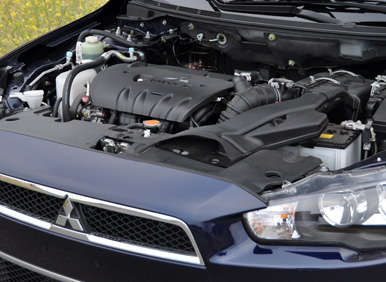
2013 Mitsubishi Lancer Sedan Road Test and Review: Driving Impressions
If you want a Lancer Evolution and think a regular Lancer is close to the same thing, it’s not. In my opinion, most of the time, a regular Lancer’s driving dynamics remind me of the dark brown Chrysler LeBaron my buddy drove in college. It feels about as quick as that old V-8, rear-drive, 1970s hand-me-down classic, and the Lancer’s cushy seats only lack Corinthian leather to exactly mimic the landscape and support offered by the ancient Chrysler.
That said, Mitsubishi claims that the Lancer SE AWC is “designed for the Snowbelt states.” Having grown up in a Snowbelt state, I’d say somebody at Mitsubishi is on the right track. Heated seats wrapped in cloth are perfect for this climate, and the soft suspension soaked up everything resembling a Michigan pothole that my local California roads could throw at it. Plus, nothing about the interior makes you worry about dragging snow, sleet, rain, or salty slush into the cabin. There’s also a hand brake located between the seats. You know what that means, eh?
One thing missing, though, is a wiper de-icer grid. Snowbelt dwellers love those. Snowbelt dwellers also like to operate the stereo while wearing gloves. That’s tough to do in this car.
Such oversights are easy to forgive thanks to the AWC system. A button on the center console allows the Lancer to operate as a front-driver when the weather is delightful, and in automatic 4-wheel drive when the weather is frightful. If a Snowbelt dweller is stuck, the AWC can be locked into an even front/rear power split for maximum traction.
While testing the Lancer SE on a sunny 80-degree day in Malibu, I didn’t need the AWC. But I did need some coffee after my drive. The soft seats, the soft suspension, the lackadaisical acceleration, the heavy steering, the droning CVT, and the combination of wind and road noise wore me out.
I will say this, however. When tossed down the backside of the Santa Monica Mountains to where Mulholland meets the ocean, the Lancer SE displayed traces of what make an Evolution so terrific: Balance, roll control, and brakes with stamina. I could envision that spoilered and scooped icon through the Lancer SE’s haze of dynamic mediocrity. And then, I turned right onto Pacific Coast Highway, and it vanished.
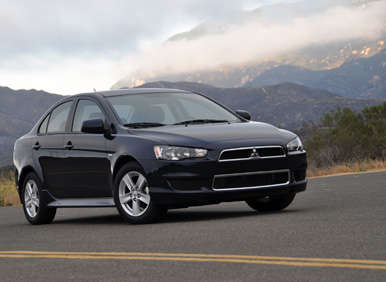
2013 Mitsubishi Lancer Sedan Road Test and Review: Final Thoughts
A Mitsubishi Lancer SE is not without merit. But neither will a model focused on delivering specific attributes to specific regional buyers be able to move the needle for this beleaguered automaker when it comes to selling cars and crossovers in America. Nothing short of a complete redesign is likely to help the Lancer increase market share against newer and more sophisticated competitors.
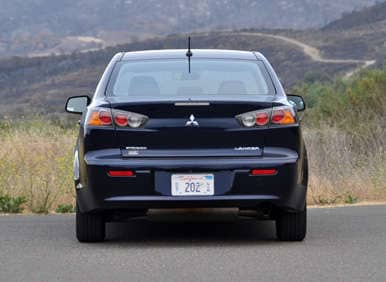
2013 Mitsubishi Lancer Sedan Road Test and Review: Pros and Cons
- Driver-selected AWD
- Top Safety Pick crash-test rating
- 10-year/100,000-mile warranty
- Appealing value equation, especially with rebates
- Observed fuel economy close to stated fuel economy
- Cushy seats and ride, if you like that sort of thing
- Cushy seats and ride, if you don’t like that sort of thing
- Inexpensive interior materials
- Lacks standard Bluetooth
- Radio knobs hard to grip
- Tight trunk space
- Almost no fun to drive
Mitsubishi supplied the vehicle for this review
2013 Mitsubishi Lancer SE photos by Christian Wardlaw
